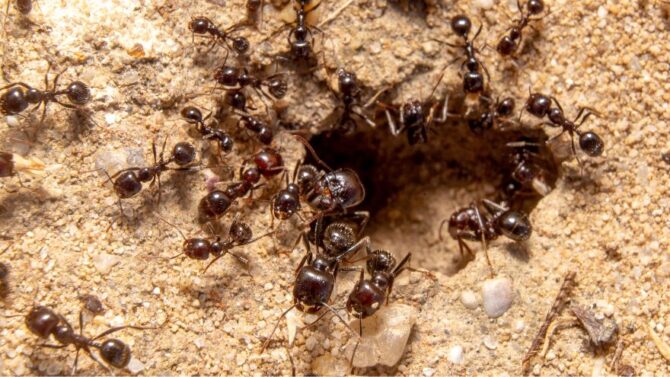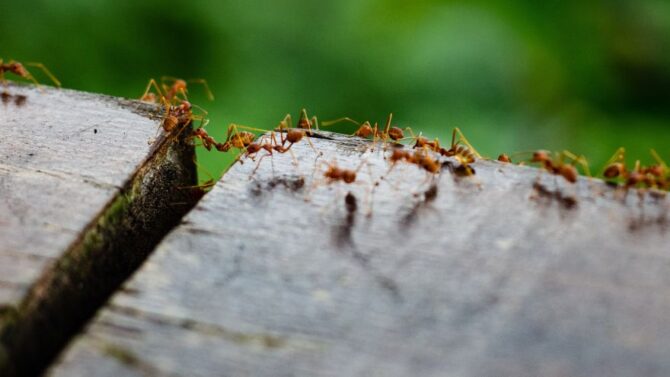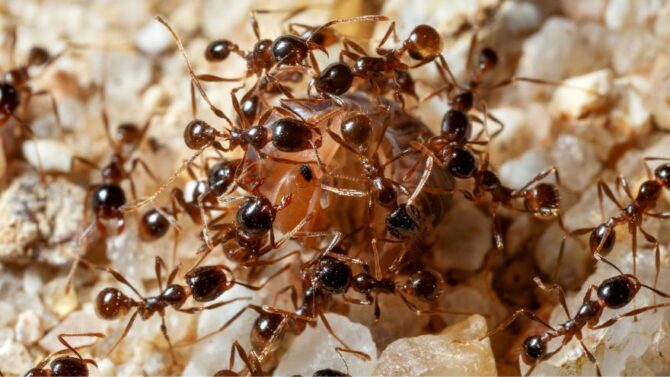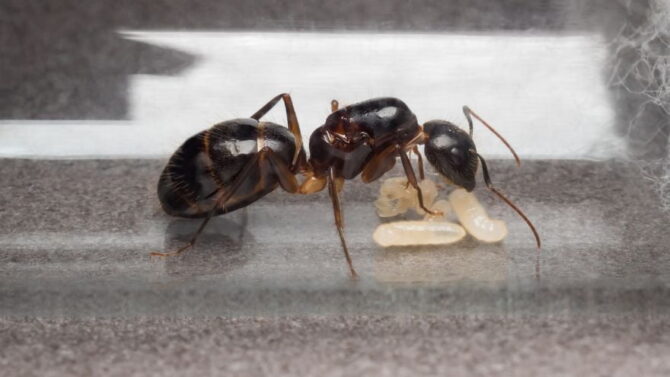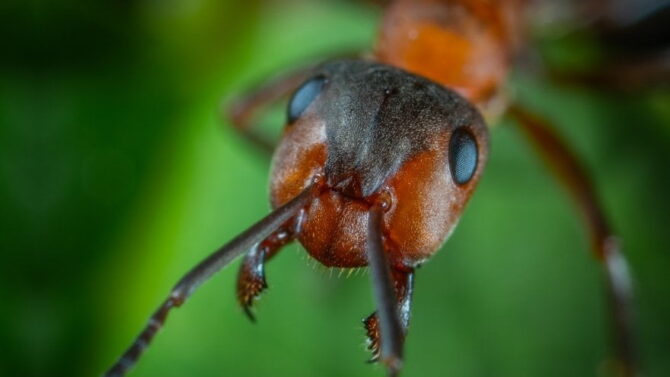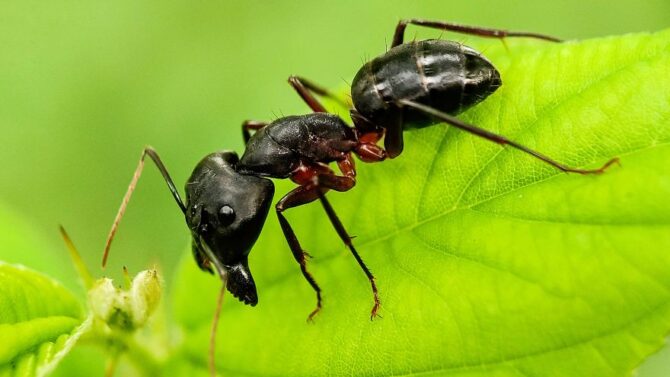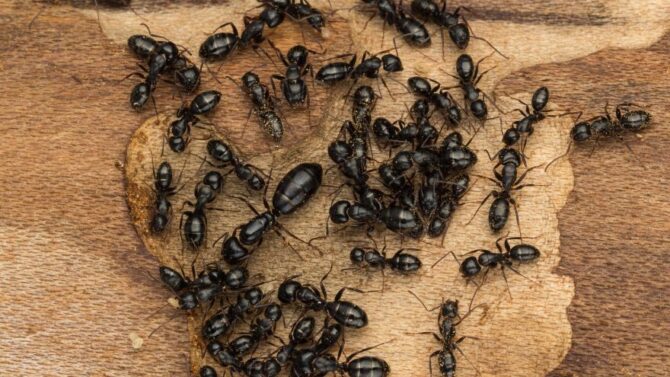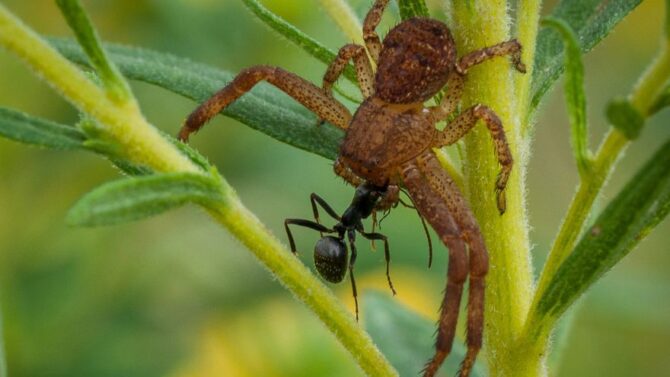Ants are eusocial insects of the family Formicidae and belong to the order Hymenoptera. They are well-known because of their number.
This is why they seem to be everywhere, including in private rooms in some human residences.
They have always intrigued thinkers and animal enthusiasts for years with their organized lifestyle and work ethics.
They’re related to bees and wasps, all of which survive in similar ways.
There are over 10,000 species in existence today, which explains their presence everywhere.
They could also be classified into three types based on their function. We have the queen, the worker, and the drone.
We’ll go into more detail on the different types in the following sections, as well as other key information you should know.
Scientific Classification
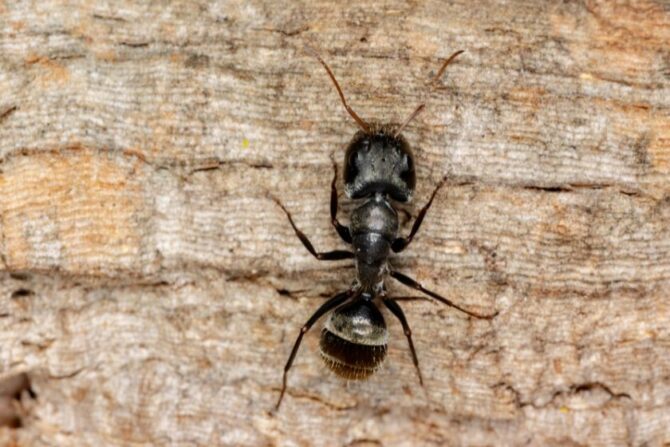
| Kingdom | Animalia |
| Phylum | Arthropoda |
| Class | Insecta |
| Order | Hymenoptera |
| Family | Formicidae |
| Scientific Name | Formicidae |
Characteristics
| Length | 0.08 inches to 1 inch |
| Venom/Poison | Yes |
| Habitat | Rocks, trees, gardens |
| Range | Worldwide |
| Diet | Omnivore |
| Life span | From weeks to years |
| Life Cycle | 38 to 45 days |
| Conservation status | Least Concern |
5 Interesting Facts About Ants
1. Ants are respected in different religions
Different religious texts view ants as significant insects, with instructions and counsels that reflect that.
The Islam prophet Muhammad forbid Muslims from killing ants, bees, the hoopoe, or shrike, according to Hadith literature.
The Bible also advises that we learn their work ethics, and Buddhists don’t kill insects.
2. They have neither lungs nor ears
A formidable quality is the absence of both lungs and ears. We say “formidable” as it raises the question of how they breathe and hear.
Ants don’t have lungs because of their small sizes. They would be unable to accommodate a respiratory system like that of humans in their small bodies. It could be the same reason they don’t have ears.
How do they hear and breathe then? They hear by using vibrations, similar to the character Toph in Avatar: The Last Airbender.
These insects use a subgenual organ found below the knee to pick these vibrations, which enables them to find food and avoid danger.
They breathe using holes that can be found on both sides of their bodies. These holes are called spiracles and are connected to themselves using tubes.
These spiracles help oxygen circulate in the body and release carbon dioxide.
3. Some species are asexual
While not common in all species, some ants do not reproduce through normal sexual means. They do so through an asexual cloning method involving only the queen.
She genetically clones herself to reproduce more females, some of which would become workers and others future queens.
With no need for them, there are no males in these colonies. The fungus gardening ant is a well-known asexual species.
4. Ants are farmers and make slaves
This particular fact might come as a surprise to you, but you’ll find it interesting as it unveils.
Humans aren’t the only living beings that farm, ants do too. We raise animals as a food source.
They do the same thing as other insects. A common insect cultivated is the aphid. They protect the aphid from predators and harsh weather, then get honeydew.
They also have slaves. This is especially common in species like the Polyergus lucidus.
They are called dulotic ants or parasitic because they rely on their slaves to survive.
They get these slave workers by raiding other colonies, eerily similar to what we have in history.
5. Ants are very old, some would say as old as dinosaurs
According to a study, ants have been around since the day of the dinosaurs.
Somehow, they’ve survived since then, even through the ice age. The current population is estimated to be a million for one human!
Given that the population isn’t set to decline anytime soon, we should expect to keep seeing these insects in years to come. Their pest tendencies aside, that is good news.
General Description
The exact appearance of an ant depends on its species. Their colors and size vary.
While some are so tiny they are hard to sight, others are visible and look like mini termites.
You would find bigger species in humid areas where they can flourish. Like all other insects, ants are invertebrates.
They have six legs, three joints, and large heads, traits many other insects share. They have very complex eyes and antennae too.
They are known to be both strong and intelligent. These insects are capable of lifting objects 20 times their weight, and each individual has an estimated 200,000 brain cells.
There are 3 different types of ants:
- Queen
- Worker
- Drone
The queen is the central individual in a colony structure, and it is due to her reproduction that any colony comes to be.
She mates with a male (the drone) and lays eggs. She also determines whether each egg will be a worker, drone, or virgin queen.
The fertilized eggs bring forth the workers and the virgin queen, while the unfertilized eggs become drones. A colony can either have one or many queens and there is no king.
Workers both serve and protect the queen as a form of survival. If a queen is killed, the colony will be endangered.
This is why workers protect her. In place of laying eggs, workers do jobs and also settle conflicts amongst themselves.
Drones live mainly for mating, and though some work, it is not their main aim.
They distinguish from other types by the darker color and have a different anatomical structure. They usually die after mating.
Distribution and Habitat
Ants can be found on every continent except Antarctica and the arctic regions. With millions in existence, this creature has a wide range.
They are experts at adapting to a particular environment, and many species will feed on whatever plant or animal matter they find. They are very common in Africa, Asia, and the Neotropical realm.
Ants live in nests that they build on their own. They can build these nests on trees, in gardens, underground, under a rock, in old logs, etc.
The materials used to build these nests include sand, twigs, and gravel.
Diet
Ants are omnivores, though the extent to which they are differs from one species to the next.
Some species aren’t picky, others focus on some specific meal. In general, they feed on fungi, leaves, honey, smaller insects, and cadavers of animals.
Their preferred diet seems to be fungi, leaves, and insects.
Because of their strength and social structure, they can lift insects and plants bigger than they are.
Workers are in charge of gathering and transporting the meal to the nest. As mentioned above, the insects’ they eat can be either alive or dead.
With their strength, ants can overcome an insect bigger than them.
Reproduction and Mating Process
The ant’s mating process is complex and life-threatening. It begins with the queen and drone meeting to mate and ends with the fertilization of the eggs by the queen.
The virgin queen and the drone have wings, and when mating season arrives the virgin queens and drones leave their nests in search of each other to mate.
The process is life-threatening because the drones and virgin queens are vulnerable to predators and other natural hurdles in the course of their flight.
The advantage of them flying away from their nests is that it reduces the chances of inbreeding.
During the mating process, the drone transfers sperm to the virgin queen.
After mating, the drone dies. Queens don’t mate more than once.
She stores the drone’s sperm in a specialized pouch until she’s ready to start a new colony. It’s a queen’s world in the ant universe.
After mating, the queen loses her wings. She then starts the next perilous journey to find the right spot for her colony.
Once she does, she starts fertilizing. She opens the pouch to use the sperm and fertilize the eggs.
She first produces a lot of worker ants using a chemical that she secretes to stunt the worker’s wing growth and ovary development.
After that, she fertilizes virgin queens. Unfertilized eggs become males.
The life cycle goes from eggs to larvae to pupae then adults. The eggs are usually small and colored cream. Larvae come without legs.
Pupas are almost like adults, except they are the same color as the eggs. Worker ants protect the eggs.
Predators and Threats
Given their size, ants have a lot of predators. Humans also threaten them by directly killing or destroying their nests.
They are edible in some areas, so in a sense, we could add humans to the list of predators.
Other common predators are reptiles, fish, bigger insects, mammals, and even insect-eating plants.
These predators hunt in different ways. They could lay an ambush, go on the pursuit or raid a nest.
Ants protect themselves by fleeing, hiding in their environment, or stinging the predator.
The strength is in the numbers, and the sting from many ants can be a problem for predators.
Behavior
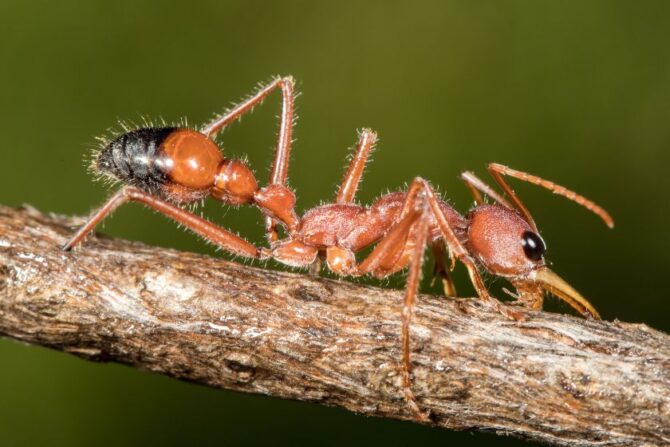
These insects are termed eusocial, which points to a high level of social structure. Some would call them extremely social, and they give good examples of cooperation and is mutually beneficial.
A solitary ant is a misnomer, and in many cases, it might have been separated from its colony.
No individual remains idle in the colony as they each have jobs to do. Even drones contribute alongside their main responsibility of mating.
The queen is the source of the colony but isn’t considered a leader. She’s protected as a means of survival.
She produces around 800 to 1,500 eggs per day. Virgin queens do not yet reproduce till it is time for them to swarm.
Ants are considered pests in many places, and because of their social nature, their presence in your home can seem invasive.
They can get in your food, build nests on your property that looks unflattering, and when damage properties.
Then there’s the sting. While the latter isn’t fatal to humans, it is nonetheless painful. You can control them yourself or get a professional.
Male vs Female
Males are drones and they always have wings. Drawing from our previous points on types, we see that there are more females in a colony.
The workers and queens are all females, while the drones are the only males.
The drones are smaller than the females with darker colors and wings. They also have smaller heads and antennae compared to females.
They remain more in the nest, and you may not see any till it’s time for them to swarm—unless you raid a nest.
Drones have the shortest life expectancy in a colony. If predators don’t get them, they die as soon as they’re done mating. In that sense, their purpose is to mate.
Frequently Asked Questions
Can an ant hurt me?
Do ants have feelings?
Are ants okay to eat?
Are ants and termites relatives?
Wrap Up
Ants are very popular, and we could learn something from them about cooperation and the need to be active.
These insects with their strength and intelligence all come with a job to fulfill. The queen is the source of others, the male mates, and the workers serve and protect.
Social behavior is worth emulating, though you shouldn’t entertain these insects as guests because of their pest nature.
